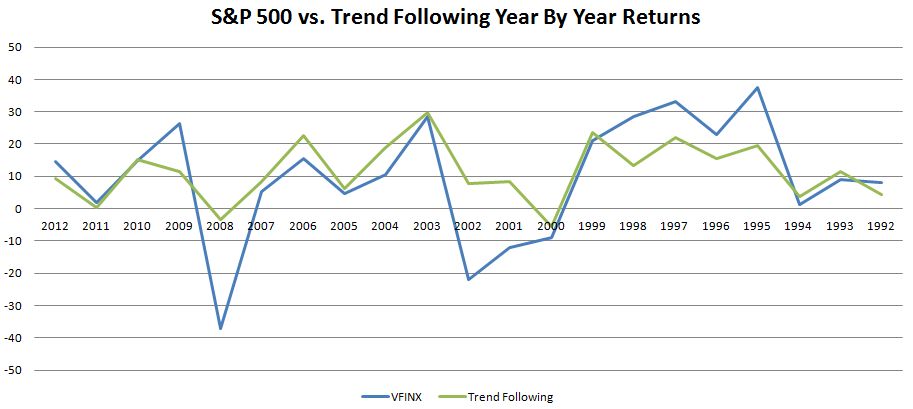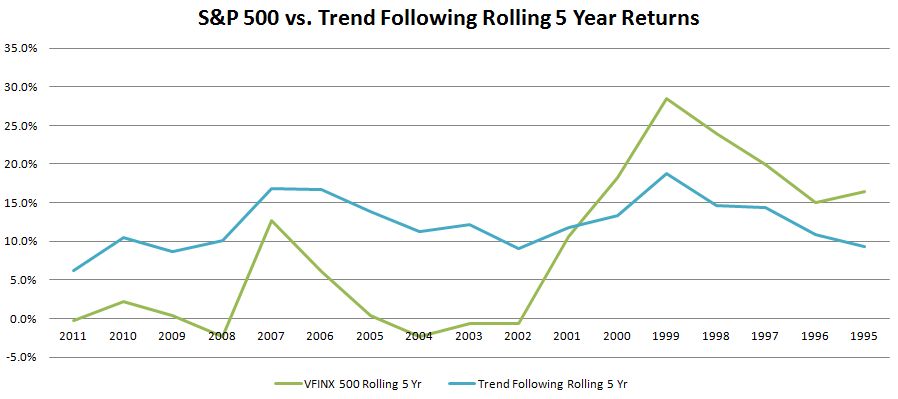Re-balance Cycle Reminder
The next re-balance time will be on next Monday, December 24, 2012. You can also find the re-balance calendar of 2012 on ‘Dashboard‘ page once you log in.
Also please beware that the re-balance calendar for 2013 is also available in a different tab on Dashboard.
As a reminder to expert users: advanced portfolios are still re-balanced based on their original re-balance schedules and they are not the same as those used in Strategic and Tactical Asset Allocation (SAA and TAA) portfolios of a plan.
Please note that we now list the next re-balance date on every portfolio page.
Tactical vs. Strategic: How Do They Perform In Secular Markets
Many users have asked us a similar question: given that our Tactical Asset Allocation has under performed Strategic Asset Allocation – Equal Weight or Strategic Asset Allocation – Optimal for the past 3 years, what can we say about the rationale behind Tactical Asset Allocation. The following is an excerpt of a user’s question:
On another subject, it would be interesting to read a discussion in the newsletter as to why, for the past 3 years, SAA has outperformed TAA. Is TAA really only beneficial when a once in a life time decline in the market occurs as in 2008/2009?
To answer this question or to understand how tactical allocations strategy performs compared with a buy and hold strategic allocation strategy, we opt to use the trend following based portfolio as a working example:
P Relative Strength Trend Following Six Assets
This portfolio has one of the longest back testing period (and now it is live and kept track on MyPlanIQ.com). The following is some information about it:
Inception date: 6/28/1991.
This portfolio tries to use the funds with the longest price history. Since international stock index funds and emerging market stock index funds have much shorter history, we use European stocks (VEURX) and Pacific stocks (VPACX) instead. In other words, we use demographic classification instead of classification based on developed and developing countries here, unlike Six Core Asset ETFs.
Funds used in this portfolio:
- U.S. stocks: Vanguard 500 Index (VFINX), inception:3/27/1987
- European stocks: Vanguard European (VEURX), inception: 11/1/1990
- Pacific stocks: Vanguard Pacific (VPACX), inception: 11/1/1990
- US REITs: Vanguard REITs (VGSIX), inception: 6/28/1996
- Gold: GLD, inception:1/4/1971. Before ETF GLD’s inception on 11/18/2004, we use London spot gold price (monthly closing).
- US Bonds: Vanguard Total Bond Index (VBMFX), inception: 6/4/1990
- CASH: calculated using 3 month T-Bill interest.
- It uses a momentum scoring strategy used in P Goldman Sachs Global Tactical Include Emerging Market Diversified Bonds ETFs. The strategy is very similar (though not identical) to Tactical Asset Allocation.
- The portfolio has risk profile 0: it can invest 100% in risk assets at certain favorable periods. So it should be really compared with S&P 500 (or VFINX) alone.
- It has one of the longest history for all trend following asset allocation studies using real index mutual funds.
- It ONLY uses real index mutual funds and thus it does not suffer from often quoted weakness for back testing including survivor-ship and data snooping.
- It is ongoing, monitored live by our system.
1. Overall Performance Comparison
The following shows how the portfolio has performed, compared with S&P 500 (using Vanguard 500 VFINX) and Vanguard Balanced Index fund (VBINX)
Portfolio Performance Comparison (as of 12/07/2012)
| Ticker/Portfolio Name | Since Inception | YTD Return** |
1Yr AR | 1Yr Sharpe | 3Yr AR | 3Yr Sharpe | 5Yr AR | 5Yr Sharpe | 10Yr AR | 10Yr Sharpe |
|---|---|---|---|---|---|---|---|---|---|---|
| VFINX (3/30/2987) | 8.7% | 15.0% | 14.9% | 110.9% | 10.9% | 58.5% | 1.0% | 2.6% | 6.5% | 25.7% |
| VBINX (6/20/1996) | 6.9% | 10.8% | 10.9% | 140.3% | 9.3% | 85.8% | 3.7% | 22.4% | 6.8% | 46.4% |
| P Relative Strength Trend Following Six Assets (6/28/1991) | 11.4% | 9.6% | 6.1% | 63.9% | 8.0% | 56.4% | 6.2% | 43.5% | 11.6% | 80.6% |
*: NOT annualized
**YTD: Year to Date
Latest Year by Year Performance Comparison >>
You can see the portfolio had a favorable overall performance in the past 21 years. But it lagged behind in the past 3 years.
Now let’s look at performance in various periods, using rolling 5 year performance.
2. Year by Year and Rolling 5 Year Performance
The following chart shows year by year performance comparison:
We see that the trend following portfolio it started to under perform VFINX in 1993 and began to out perform since 2000 when the internet bubble bursted. It then started to under perform the index since 2009.
The following shows the average annualized returns in rolling 5 years:
It now becomes more evident that for a rolling 5 year window, the trend following portfolio under performed in the first part of the time window: from 1995 to 2000 and then it out performed since.
3. What Can We Say About Tactical vs. Strategic
Let’s make some observations about how tactical and strategic are compared in different market cycles:
- Both Tactical (Trend Following) and Strategic can have advantages in different secular cycles.
- In the raging bull market since 1995, the strategic buy and hold out performed the tactical.
- Notice that the tactical, though under performed S&P 500, still managed to have very meaningful returns — 13.97% annual return from 12/31/1991 to 12/31/1999 (users can click on More Performance Analytics and then Calculate Performance for A Period on the portfolio page of P Relative Strength Trend Following Six Assets and input the start and end date to calculate the above figure).
- It is natural to see that the Tactical out performed in the rolling 5 year period after a bear market began, such as from 2000 and from 2008.
- However, from 2003 to 2007, after the internet bubble induced bear market was over, the tactical out performed S&P 500 every year. This is a bull market period.
- In the most recent ‘bull’ market since 2009, the tactical has under performed every year.
To synthesize:
- Tactical can still deliver respectful returns in a raging bull market such as the period of 1995 to 1999.
- Tactical can still beat strategic even in a bull market such as the period of 2003 to 2007.
- Strategic can outshine tactical in a ‘weak’ or ‘uncertain’ bull market such as the periods of 2009 to present and 1991 to 1995.
- Strategic can outshine tactical in a raging bull market.
Portfolio Performance Update
The following shows how strategic portfolios in our featured ETF plans have performed so far:
Portfolio Performance Comparison (as of 12/07/2012)
| Ticker/Portfolio Name | 1 Week Return* |
YTD Return** |
1Yr AR | 1Yr Sharpe | 3Yr AR | 3Yr Sharpe | 5Yr AR | 5Yr Sharpe | 10Yr AR | 10Yr Sharpe |
|---|---|---|---|---|---|---|---|---|---|---|
| MyPlanIQ Diversified Core Allocation ETF Plan Strategic Asset Allocation – Equal Weight Moderate | 0.4% | 8.4% | 7.8% | 102.9% | 7.1% | 69.1% | 2.3% | 13.6% | 7.8% | 55.1% |
| Six Core Asset ETFs Strategic Asset Allocation – Equal Weight Moderate | 0.4% | 8.1% | 7.5% | 88.3% | 7.4% | 65.2% | 3.0% | 16.6% | 7.6% | 47.8% |
| Permanent Global Portfolio ETF Plan Strategic Asset Allocation – Equal Weight Moderate | 0.5% | 8.6% | 6.5% | 74.5% | 7.4% | 60.9% | 4.0% | 22.5% | 8.6% | 57.1% |
| Vanguard ETFs Strategic Asset Allocation – Equal Weight Moderate | 0.8% | 9.6% | 9.7% | 119.5% | 8.5% | 64.9% | 2.7% | 13.3% | 7.9% | 45.7% |
| Retirement Income ETFs Strategic Asset Allocation – Equal Weight Moderate | 0.8% | 11.5% | 12.8% | 174.6% | 8.3% | 76.5% | 2.7% | 15.2% | 9.2% | 62.1% |
*: NOT annualized
**YTD: Year to Date
See the up to date comparison >>
Market Overview
International and emerging stocks are taking up the top two spots, with high yield bonds taking the 3rd place in our major asset trend score ranking table on Asset Trends & Correlations. Many investors including ourselves are perplexed by recent market strength. Fortunately, we have investment strategies such as tactical and strategic firmly in place and we will use them as guides.
It is also very interesting to see that international REITs (VNQI or RWX) is ranked even higher than any other major asset class. See more details on 360° Market Overview. On the other hand, it is not surprising to see that in a period of muddling through with extremely low interest rates all over the world, hard assets that have solid yields (read REITs, rental properties) are chased by investors.
We again copy our position statements (from previous newsletters):
Our position has not changed: We still maintain our cautious attitude to the recent stock market strength. Again, we have not seen any meaningful or substantial structural change in the U.S., European and emerging market economies. However, we will let markets sort this out and will try to take advantage over its irrational behavior if it is possible.
We again would like to stress for any new investor and new money, the best way to step into this kind of markets is through dollar cost average (DCA), i.e. invest and/or follow a model portfolio in several phases (such as 2 or 3 months) instead of the whole sum at one shot.
Latest Articles
- Asset Correlations As A Guide To Portfolio Construction
- Equity Funds Continued Their Exodus, Again
- Threats to a fulfilling retirement
- Coping With the New Normal
- What Are the Core Asset Classes for Total Return Portfolios?
- Tax on Dividend-Paying Stocks Rising to 74%
- Should the US Reform the Student Loan System?
- Emotions In S&P 500 Stocks
- The Wisdom of Jack Bogle: Part 2
- Fed Model Casualty of Paradigm Shift
- Four reasons dividends won’t fall off ‘fiscal cliff’
- December 3, 2012: Asset Trends & Correlations For Portfolio Construction
How can we improve this newsletter — we value your inputs –Thanks to those who have already contributed — we appreciate it.



 Diversified Asset Allocation Portfolios For Your Plans
Diversified Asset Allocation Portfolios For Your Plans

Any explanation why the relative strength one was better from 2003 to 2007 while worse before 1995? Both are rising markets.
Jerry, I believe you meant from 1995 to 2000. For these two bull markets, in the one in 1990’s, US stocks has been the best performer while in the one from 2003 to 2007, globalization and weak US dollar and loose real estate lending made emerging market stocks and REITs exceptionally strong. The relative strength algorithm was able to take advantage of this and invested in REITs and foreign (emerging market included) stocks.
All in all, diversification helps the algorithm to take advantage of bull markets in some asset classes. This explained the difference between 1990’s and 2003-2007.
We will have more on this in a follow up newsletter.
Thanks,
John
Hi:
Tactical vs. Strategic post above was very helpful. My question is if one wanted to switch over from Strategic to Tactical in response to a bear market, do you offer any signal that such a switch should be done and when to do it, or can you suggest what to monitor to confirm a crossover from one market to another? I love that each does well in different markets, but it seems to me an optimal overall strategy would be one that has you switch between tactical and strategic to get best returns.
Thanks, Fred